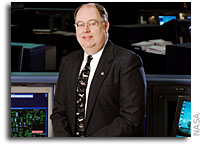Wayne Hale’s NASA Blog: Stormy Weather

My last assignment as Ascent/Entry Flight Director for the space shuttle was for STS-113 in the fall of 2002. It was a memorable flight, several technical delays and then a spectacularly successful mission to the International Space Station. Of course you remember the one day we delayed for weather, don’t you? I certainly remember because it is etched in my memory.
Obviously we must have good weather to launch. Florida is lightning capital of North America; afternoon thunderstorms are typical, changing winds are to be expected, clouds and low visibility are normal. But some of the Florida days are crystal clear blue with light winds and we really like to take advantage of those days to launch. Except I had to scrub for weather on a beautiful Florida fall day.
The shuttle rules are based on the principle that something might go wrong during the launch phase and the crew should have a fighting chance of landing somewhere with reasonable weather. To ensure that, the flight rules are long, arcane, and tedious, and make the Weather Officer watch not just the Florida weather, but weather at landing fields all up the east coast of North America, from South Carolina to Canada; then weather in the British Isles, Spain, Morocco, a little African country called The Gambia, Greece, Turkey, Saudi Arabia, Diego Garcia, Hawaii, and whew, back home to the mainland where California and New Mexico have abort landing sites. Weather doesn’t have to be good everywhere — that is impossible — but there are categories where at least one of a group of nearby runways must have good weather. Otherwise, the rules call for the Flight Director to call for a scrub.
The trickiest abort is the Return to Launch Site (RTLS). Weather must be good at the Shuttle Landing Facility, about 5 miles west of the launch pad, and here is the tricky part – 20 to 30 minutes after launch. As Yogi Berra observed: “Forecasts are difficult, especially about the future.”
In spite of the complex abort landing site weather rules, if the weather in Florida is good for both launch and RTLS, it has been very rare to scrub a launch for bad weather at the other abort landing sites.
On that beautiful fall day in Florida, with the crew on board and the tank full of gas, both landing sites in Spain had thunderstorms at the field with strong winds, precipitation, and – worst of all – lightning. The shuttle is particularly vulnerable to lightning. So I had to call for a scrub. No-Go for TAL weather.
For all the dignitaries and senior NASA officials at the viewing stands in Florida, this was a serious disappointment. Cooler heads would recognize that this was a good decision, but some were clearly wondering what the stupid Ascent Flight Director was thinking — weather is perfect for a launch in Florida — why do we care about Spain?
Having been around the block a few times, I was well aware of the buzz that was probably developing a thousand miles east of Mission Control. But, better to scrub a day for safety than to put the crew in a bad situation. If a TAL abort occurred and the weather caused a bad day at the runway, nobody would ever forget it; especially me.
One thing I have never understood. Some of my co-workers bide their time for the day they reach NASA retirement age, and say that they will tell their management what they really think when they have a pension in hand and can walk out the door safely. Worrying that telling the boss the truth has never been part of my make up. If they don’t like the truth, too bad. I’ve rarely had a boss at NASA take my truth telling in a bad way. This weekend, I reach the magic NASA retirement age. Will it make any difference in my outspokenness? I doubt it, but we’ll see.
Now, from time to time, NASA is blessed with retired military flag officers. Admirals and Generals who have ably served their country for many years achieve military retirement age and come back for a second career on the civilian side of the government. Often these folks provide capable leadership and invaluable knowledge. Sometimes, these folks merely occupy a square on the org chart and never understand what we do or how we do it, and we must find ways to work around them. On rare occasions, one of these retired military officers takes it on himself to become the drill instructor to NASA to mold us into a different, more military culture.
After the launch was scrubbed, I had a call from one of those retired flag officers who just happened to recently come into my chain of command. At rather high decibel levels I heard all about the all weather capabilities of current military fighter aircraft. I heard all about how badly delaying schedules hurts the program. I heard all about how a good leader would have made a better judgement call and proceeded to launch. On and on.
After I hung up the phone I thought about how little he understood our work. How vulnerable and fragile are our spacecraft. And how much care is required to fly safely in space. Sometimes it is not a popularity contest, and you just have to accept that.








